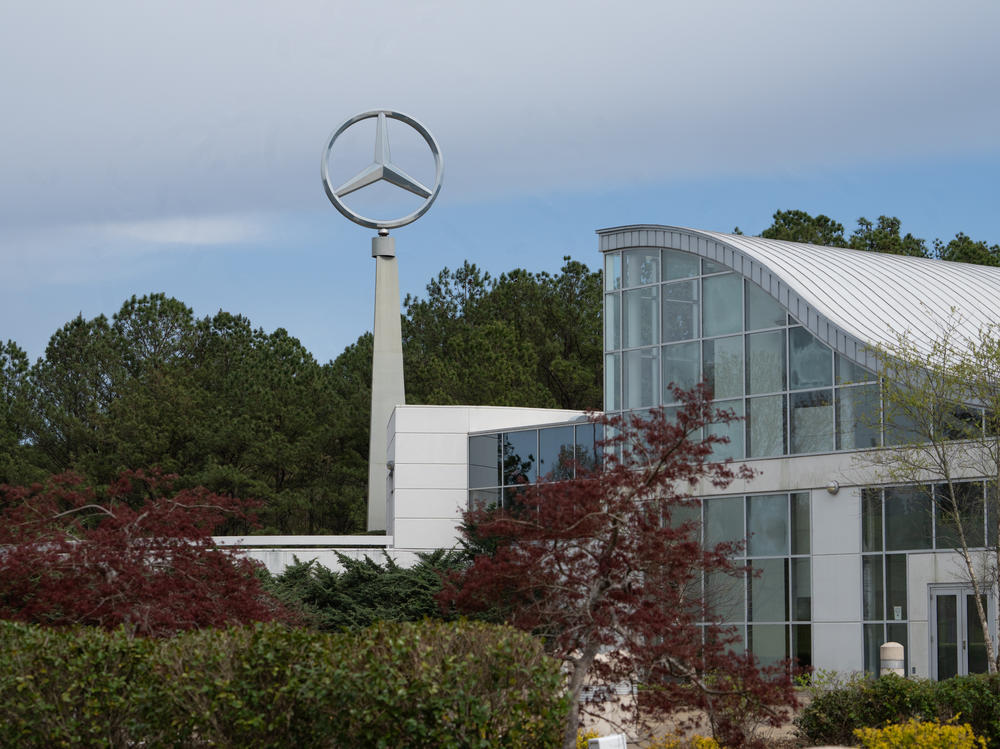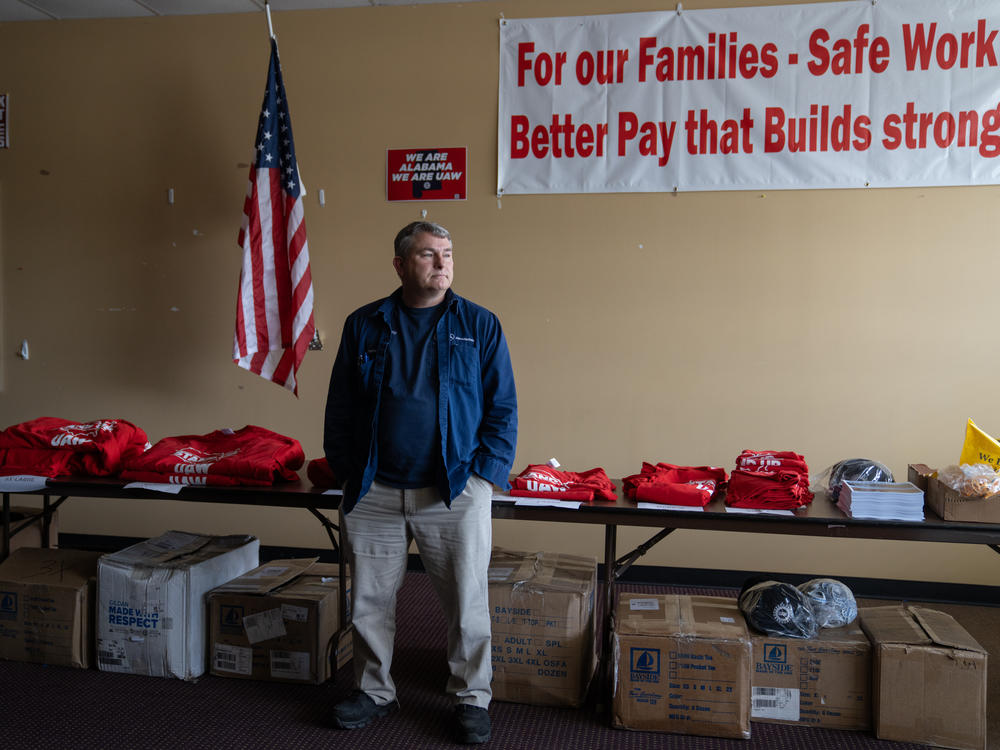Section Branding
Header Content
Seeking to defy history, the UAW is coming closer to unionizing in the South
Primary Content
The United Auto Workers union has stepped up the pace on its march south.
On Friday, Mercedes workers in Vance, Ala., filed a petition with federal labor officials for a union election — a first for workers at that plant. Volkswagen workers in Chattanooga, Tenn., will begin voting in their union election in less than two weeks.
The surge in union interest follows the UAW's strike against the Big 3 automakers last fall, which led to record contracts.
"We started signing [union] authorization cards Thanksgiving weekend, and it just stacked up quick," says Jeremy Kimbrell, who's worked for Mercedes for 24 years, starting out in the paint shop in 1999. "It was like workers were starving for it, and it took off."
The UAW has targeted the South before with little success. The Volkswagen plant voted against unionizing twice, first in 2014, then in 2019. Decades of campaigns at the Mercedes plant failed to gain enough traction to get to a union vote.
That was never surprising, given the South's longstanding antagonism toward labor unions. Right-to-work laws that blanket the region prohibit employers and unions from forcing employees to become union members and pay dues. Voters in Alabama and Tennessee approved constitutional amendments enshrining those laws in 2016 and 2022.
Nevertheless, in the swift few months since the UAW set its sights on non-union plants, pledging $40 million for the cause, organizers have been able to get well over a majority of workers at Volkswagen and Mercedes to sign union authorization cards. The UAW needs only a majority of ballots cast in favor of the union to win an election.
Once a good job, now not good enough
Moesha Chandler sought out a job at Mercedes early last year, drawn by the company's reputation as one of the best-paying employers in a region without a whole lot of opportunities.
"Everyone was mostly trying to get a job at Mercedes where I came from," says Chandler, who worked at the Mercedes battery plant for a couple months before being moved to an SUV assembly line.
But over the last year, she's soured on the place, finding the long hours and grueling work not worth it for the wages she takes home — $24 an hour.
She was also offended by the two-tier wage system that the company introduced in January 2020. New hires were to top out at a wage that was $5 an hour less than what existing employees could make, according to workers at the plant. Union organizers say Mercedes ended the system after the union drive got underway and also announced new raises.
Mercedes declined to comment on its pay structure, only writing in a statement that the company has a proven record of competitively compensating employees.
Still, wages are a major reason why Chandler became an active campaigner for the UAW. In recent days, she says, she doesn't even have to seek out coworkers on the production line. They come to her.
"They're like, 'What's the next move? What's the next step?' The momentum is great," she says.
How wages became an issue
For years, Mercedes paid wages that were comparable to those paid to union workers at Ford, General Motors and Stellantis (formerly Chrysler), says Stephen Silvia, professor at American University and author of the book The UAW's Southern Gamble.
"They paid the high compensation to keep the union out," says Silvia.
But in recent years, Mercedes leadership has let compensation slide, according to workers. Wages stagnated and the two-tier system was introduced. Silvia says the automaker may have been looking to maximize profits as it confronted the costly transition to electric vehicles.
"That's going to be a terribly expensive thing to engage in," says Silvia. "So trying to get as much money where you can is something that all the auto companies are doing."
The pay issues play right into the UAW's current strength. The union successfully negotiated higher wages and better benefits with the Big 3 automakers last year. That gave the UAW a much-needed win to sell to Southern workers.
"The UAW showed that it could deliver," says Silvia.
Union naysayers on the factory floor
Within the Mercedes plant, there are workers warning about the potential pitfalls of unionization.
Jay White, a parts quality technician who's worked at the plant since 2005, points to layoffs at the Big 3 since the new contracts were signed last fall. While he attributes some of the cuts to the lack of success automakers are having selling EVs, he believes the wage increases have also played a part.
"You increase costs, they got to cut it back somewhere," he says.
These days, White wears an anti-union sticker on his shirt and carries extras to hand out to whoever wants one. He's also been letting coworkers know they can revoke their union authorization cards if they change their minds.
On the plant floor, he has found plenty of workers who share his view that a union would be a bureaucratic hindrance. But having been through several union campaigns over the years, he senses that there's more pro-union sentiment now than in the past.
"It might be a sign of the times. It may be a generational situation," says White. "I don't think people understand the rules and restrictions that come along with unionization."
A threat to an economic model?
Southern politicians have offered their own biting criticism of this latest UAW push, framing their opposition as a move to protect jobs.
"Alabama has become a national leader in automotive manufacturing, and all this was achieved without a unionized workforce," wrote Alabama Governor Kay Ivey in an op-ed for the Alabama Department of Commerce.
"Make no mistake about it: These are out-of-state special interest groups, and their special interests do not include Alabama or the men and women earning a career in Alabama's automotive industry."
While picking Alabama for an assembly plant may have been a gamble for Mercedes in the 1990s, the Deep South has since become one of the country's leading automobile manufacturing regions. Mazda, Toyota, Hyundai and Honda also have plants in Alabama. Mercedes itself has since expanded its plant, announcing a $1 billion investment in 2017 for building EVs.
Kimbrell, the longtime production worker, knows that Alabama's right-to-work laws and largely non-union workforce were a big part of what drew automakers to Alabama in the first place. But he scoffs at the idea that Mercedes would pick up and leave the state should workers vote to unionize.
"The plant is established. A whole lot of the plant's brand new. We've got a proven workforce building top-notch vehicles," says Kimbrell. "This plant's going nowhere."



